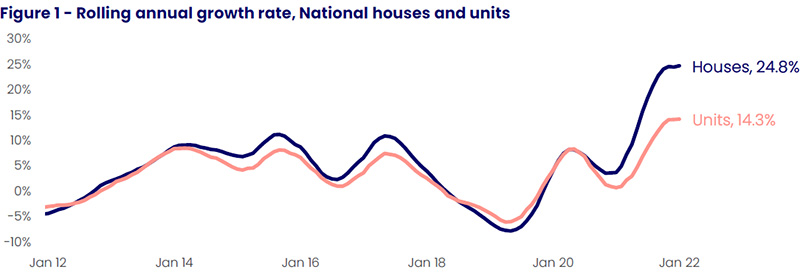[ad_1]
The disparity between Australia’s house and unit values reached an all-time high in January.
The disparity between Australia’s house and unit values reached an all-time high in January, despite double-digit annual growth rates for both houses and units.
CoreLogic’s new monthly Unit Market Update shows units recorded an annual growth rate of 14.3 per cent in the 12 months to January while house values rose 24.8 per cent over the same period.
When combined, it’s Australia’s highest annual dwelling growth rate since 1989, but with a house versus unit disparity of 28.3 per cent.
Report author CoreLogic Research Analyst Kaytlin Ezzy says although house growth has traditionally outpaced unit growth over the past decade, the performance gap throughout the current upswing has been notably higher than in previous cycles, thanks in part to COVID-related demand shocks disproportionately affecting unit demand.
“The annual performance gap between houses and units began to narrow in the final three months of last year, in part due to the lifting of lockdowns and border restrictions as well as increasing affordability constraints diverting demand towards the medium to high-density sector,” Ms Ezzy said.
“However, in January we saw that annual performance gap start to widen again, which could, in part, be explained by the disparity between advertised house and unit supply.
“Shortages in advertised listings throughout COVID has helped fuel value growth by creating a sense of urgency among buyers.”
Source: CoreLogic
During January 2022, the total advertised unit supply in Australia’s combined capital cities was down 3.7 per cent compared to the same time last year and 7.8 per cent below the previous five-year average. Over the same period, capital city house listings were down 12.5 per cent compared to this time last year and 32.7 per cent below the five-year average.
While unit values have continued to underperform nationally, growth conditions are becoming more diverse among the individual capitals and rest of state regions.
Canberra (5.6 per cent) Darwin (2.6 per cent), regional Victoria (5.7 per cent) and regional Tasmania (9.2 per cent) all recorded stronger unit growth over the three months to January when compared to their respective housing markets.
Ms Ezzy says with the exception of Darwin, the total advertised unit stock in each of these markets was more than 30 per cent below the previous five-year average.
Units ruling some markets
A multi-speed dynamic is also beginning to emerge across the combined capitals. Adelaide led the pace for unit gains, recording a monthly rise of 1.5 per cent followed by Brisbane (1.4 per cent).
Unlike the other capital city markets where growth rates have eased, Brisbane and Adelaide are yet to show signs of a slowdown in momentum, with each city recording a new cyclical high over the 12 months to January of 13.8 per cent and 9.5 per cent respectively.
Hobart’s unit market is the standout performer in the 12 months to January 2022, as median values hit $574,993, up 32.8 per cent over the year compared to a 26.3 per cent capital gain for houses. Melbourne recorded a modest fall in unit values, down 0.4 per cent through January for an annual growth of 8.1 per cent.
Perth’s monthly growth rate remained flat while Sydney unit values increased 0.1 per cent over January following the 0.2 per cent fall in values recorded in December. Sydney unit values rose 15.4 per cent in the 12 months to January 2022.
Despite rising inflation, the prospect of a rate hike in late 2022, affordability constraints and tighter lending restrictions, Australia’s unit market may benefit from some tailwinds in 2022, Ms Ezzy said.
“Three of the eight capital cities now have a median house price in excess of $1 million and the gap between national house and unit values is at an all-time high,” she said.
“It is likely affordability constraints will gradually pull some demand away from houses towards more affordable units and with international borders opening this month, Australia may gradually see a return to pre-COVID levels of migration.
“As most migrants initially rent in Sydney or Melbourne, this could help bolster rental demand in those markets hardest hit by the pandemic, which, in turn, could boost investor demand and ultimately, unit prices.”
[ad_2]
Source link

